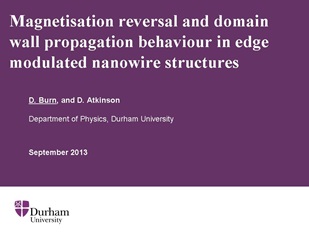
Magnetisation reversal and domain wall propagation behaviour in edge modulated nanowire structures
D.M. Burn and D. Atkinson
Donostia International Conference on Nanoscaled magnetism and Applications San Sebastian, Spain Sep 2013
Magnetisation reversal processes in ferromagnetic nanowires are of fundamental physical interest and also attract significant interest due to their potential exploitation in novel spintronic devices.[1,2] Techniques for the control of domain walls in nanowires are important and geometrical structuring is widely used for the controlled pinning of domain walls with individual geometrical features[3]. Nanowire structuring can even lead to improved domain wall dynamics due to the suppression of the Walker breakdown process[4].
Here the magnetisation reversal behaviour in lithographically defined edge modulated nanowire structures are studied in two regimes, first by nucleation controlled reversal and secondly, by domain wall propagation. In the latter case, domain walls were introduced both with 'nucleation pad' structures and through local pulsed field injection techniques.
The reversal behaviour shows a complex dependence on the modulation parameters involving competing contributions to the energetics of the magnetisation reversal. This gives rise to a minimum reversal field for specific modulation parameters showing that wire parameters can be optimised for both static and dynamic magnetisation processes.
The experimental results obtained here are supported by a detailed series of micromagnetic simulations and an analytic model, developed based on demagnetisation effects of the modulation upon the spin structure of the wire. This analysis highlights consistent trends in the reversal behaviour resulting from the modulation. Significantly, the reversal behaviour is found to be scalable in relation to the amplitude and the wavelength of the modulation[5].
[1] D.A. Allwood et al., Science 309, 1688 (2005)
[2] S.S.P. Parkin et al., Science 320, 190 (2008)
[3] L.K. Bogart et al., Phys. Rev. B 79, 054414 (2009)
[4] Y. Nakatani et al., Nat. Mat. 2, 521 (2003)
[5] D. Burn et al., Phys. Rev. B 88, 104422 (2013)